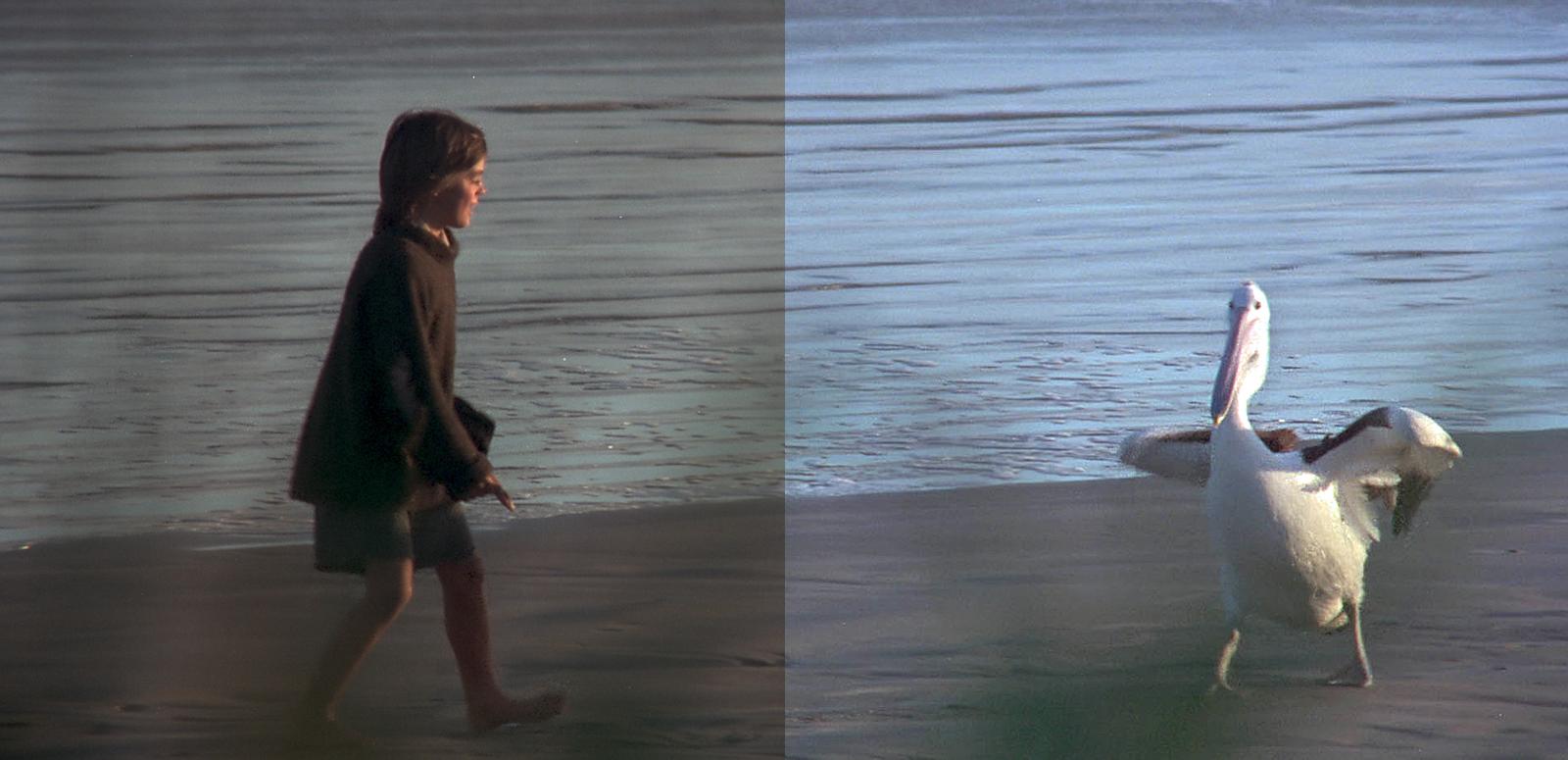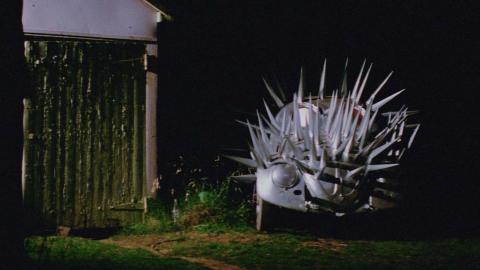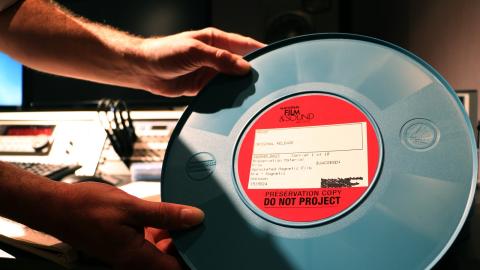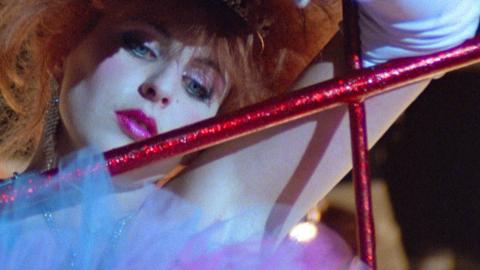

NFSA Restores
NFSA Restores
Film is part of the DNA of this country, and to experience it on the big screen fills us with a sense of who we are as Australians. Together we can preserve our film culture, the stories we want to keep telling.
Margaret Pomeranz, NFSA Ambassador
NFSA Restores is an exciting program to digitise, restore and preserve, at the highest archival standards, classic and cult Australian films so they can be seen on the big screen in today’s digital cinemas.
Our collection belongs to all Australians but it is fragile. Films, tapes, recordings, photographs and costumes can all deteriorate over time and need constant care.
We're always working to preserve Australia's audiovisual collection and make it available to as many people as possible. But we can do so much more with your help.
Support the preservation of Australia's audiovisual history. Donations over $2 are tax deductible.
THE RESTORED FILMS
For more clips from NFSA Restores films, see the NFSA Restores curated collection.
Flirting (1991)
The NFSA restoration of Flirting premiered at Arc cinema in Canberra in August 2017.
At a private boys’ school in 1965, class misfit Danny Embling (Noah Taylor) finds his romantic soulmate in Thandiwe (Thandie Newton), a precocious, intelligent girl of African heritage from the nearby private girls’ school. After misunderstandings and misadventures they come together for a sweet if regrettably brief period that neither of them will ever forget.
Restoration notes
Flirting is the sequel to writer-director John Duigan’s 1987 award-winning The Year My Voice Broke. It stars Noah Taylor and Britain’s Thandie Newton, in her first significant screen role, with memorable early roles for Nicole Kidman and Naomi Watts. John Duigan comments, 'The work of film preservation is of incalculable value to our culture. Without it whole swathes of our film heritage, including classics from the relatively recent past, may, sooner than we think, be lost forever.'
Shame (1988)
The NFSA restoration of Shame premiered at the 2017 Melbourne International Film Festival with director Steve Jodrell and stars Deborra-lee Furness and Simone Buchanan in attendance.
Perth lawyer Asta Cadell (Deborra-lee Furness) crashes her motorcycle near a small town in Western Australia, where a ‘boys will be boys’ culture allows rape and violence against women. Asta tries to help a young woman (Simone Buchanan) who has been gang-raped, inspiring local women to stand up and rally against criminal behaviour that has gone unpunished.
Restoration notes
Director Steve Jodrell comments on the NFSA restoration, ‘It has an immaculate freshness and luminosity that reminds me of its initial screening almost 30 years ago. There’s a powerful message in the film – sadly, one that is even more relevant today than when it was first released’. On the film's release in 1988, Deborra-lee Furness' performance earned her best actress awards from the Film Critics' Circle of Australia and Seattle International Film Festival. She says now, ‘Shame remains one of my favourite films that I have worked on. I remember the response this film received when it was released, how potent the message was, and how this story resonated globally. I am thrilled that Shame has been restored so that this beautifully crafted film will continue to have an audience.’
The Year My Voice Broke (1987)
The NFSA restoration of The Year My Voice Broke premiered at the 2017 Sydney Film Festival on 10 June.
Danny (Noah Taylor) is a gawky 15-year-old, in love with his best friend, the beautiful and free-spirited Freya (Loene Carmen). They’re misfits in a country town in NSW in 1962. When Freya falls for football star Trevor (Ben Mendelsohn), Danny’s sexual longing turns to jealous confusion. As he tries to win her back, Danny uncovers a dark secret in the town’s past.
Restoration notes
The NFSA has just completed a digital restoration of my film The Year My Voice Broke. Made 30 years ago, the negative in a few places was already showing early signs of degrading, and if this preservation work had not been undertaken, sections may well have been irretrievably lost. Thanks to the care and meticulous attention to detail of Senior Curator Gayle Lake and her team, a definitive and very beautiful digital version of the film will now be preserved, and I am delighted that it will be premiered as part of the 2017 Sydney Film Festival. The work of film preservation is of incalculable value to our culture. Without it whole swathes of our film heritage, including classics from the relatively recent past, may, sooner than we think, be lost forever. Writer-director John Duigan
Sons of Matthew (1949)
The NFSA’s digital restoration of Sons of Matthew (1949) premiered at Arc cinema, Canberra in March 2017.
It is the most personal work of legendary Australian filmmaker Charles Chauvel, paying tribute to the pioneering farmers of northern New South Wales and south-east Queensland where he grew up. The intergenerational western depicts the challenges facing a farming family across decades, with dramatic action sequences that hold up well 70 years after it was made.
Restoration notes
Sons of Matthew is arguably Chauvel's most ambitious work, with production taking 18 months to complete and filming in Queensland badly affected by flooding and heavy rain. The film was nevertheless a huge success with local audiences when it opened in December 1949, and was also released in the UK and US (as The Rugged O'Riordans).
Three Days to Live (1924)
The NFSA’s digital restoration of Three Days to Live (1924) premiered at Arc cinema, Canberra in February 2017 with a live piano accompaniment by Mauro Colombis. Once thought lost, Three Days to Live is one of the earliest known titles to include the work of Oscar-winning filmmaker Frank Capra.
Three Days to Live is a mystery set across San Francisco’s share market and ‘exotic’ India, where a shadowy investor is targeting fellow investors, forcing them into bankruptcy. Capra is credited as Titles and Editor. It is also thought, according to biographer Jim McBride, that Capra was assistant director.
Three Days to Live – 2017 restoration trailer. Director: Tom Gibson; Cast: Ora Carew, Jay Morley.
Restoration notes
Three Days to Live was first brought into Australia in 1925, with the earliest recorded screenings in Tasmania and South Australia at Port Pirie’s Alhambra Theatre. ‘From attempts to locate the film elsewhere it appears the NFSA holds the only identifiable copy of the film, so it is very unique': NFSA Film Curator Sally Jackson. The year-long restoration project secures an important piece of Australian and world cinema history.
The Odd Angry Shot (1979)
The NFSA’s digital restoration of The Odd Angry Shot premiered in Tasmania in August 2016 to commemorate the 50th anniversary of the Battle of Long Tan.
The Odd Angry Shot follows a single tour of duty of an Australia Special Air Service Regiment reconnaissance team in Vietnam, and their daily life in camp. Directed by Tom Jeffrey, the 1979 film features an all-star cast including Graham Kennedy, Bryan Brown, John Hargreaves and John Jarratt.
The Odd Angry Shot – 2016 restoration trailer. Director: Tom Jeffrey; Producers: Tom Jeffrey, Sue Milliken; Cast: Graham Kennedy, John Hargreaves, John Jarratt, Bryan Brown, Graeme Blundell.
Above: The Odd Angry Shot – 2016 restoration trailer. Director: Tom Jeffrey; Producers: Tom Jeffrey, Sue Milliken; Cast: Graham Kennedy, John Hargreaves, John Jarratt, Bryan Brown, Graeme Blundell.
Restoration notes
The Odd Angry Shot is less about the politics of Australia’s involvement in the war than the men, the conflict and their adjustment to life back home. ‘The new digital print is fantastic and it has given [the movie] a new lease of life. [The film] remains the only Australian motion picture dealing with our participation in the Vietnam War, and is a tribute to the professionalism of our soldiers serving in extremely difficult circumstances.’ Writer-director Tom Jeffrey
Proof (1991)
The NFSA restoration of Proof premiered at the 2016 Melbourne International Film Festival on 29 July 2016.
Martin (Hugo Weaving), a visually impaired man, lives an emotionally isolated life. Holding a deep-seated mistrust for the people around him, he takes photographs of his surroundings as a safeguard against being deceived. An object of obsessive but unrequited desire for his housekeeper (Genevieve Picot), Martin embarks on a cautious friendship with a young restaurant worker (Russell Crowe). In doing so, he sets in motion a love triangle in which trust can be built and shattered.
Proof (1991) restoration playlist. Director: Jocelyn Moorhouse; Producer: Lynda House; Cast: Hugo Weaving, Russell Crowe, Genevieve Picot.
Above: Before and after restoration clip from Proof (1991). Director: Jocelyn Moorhouse; Producer: Lynda House; Cast: Hugo Weaving, Russell Crowe, Genevieve Picot.
Restoration notes
In May 2016 the NFSA asked the public to help us fund the restoration of Proof. Over the course of 45 days, we were able to raise $27,000, thanks to the generosity of 266 film lovers from across Australia and around the world. Whether they gave two or two thousand dollars, each one of their donations was crucial to help us reach our goal. Their contribution is not only financial; their support is a vote of confidence in the work of the NFSA, and proof that Australians care about the preservation of their film history.
Bliss (1985)
The NFSA restoration of Bliss premiered at the 2016 Sydney Film Festival.
Harry Joy (Barry Otto) dies – for four minutes – after a heart attack. When he is revived, he suspects he’s living in hell. His wife Bettina (Lynette Curran) is having an affair with his business partner Joel (Jeff Truman), his son David (Miles Buchanan) sells cocaine and Harry’s advertising agency promotes products that cause cancer. Harry turns over a new leaf when he meets a north coast hippie, Honey Barbara (Helen Jones), and begins the long process of earning her trust, and his own redemption.
Above: Restoring Bliss (1985). Director: Ray Lawrence; Producer: Anthony Buckley; Cast: Barry Otto, Lynette Curran, Helen Jones.
Restoration notes
There are actually three versions of Bliss, Ray Lawrence’s bold satire that premiered at the Cannes Film Festival and went on to win three AFI Awards. Once the NFSA confirmed that the interpositive and final mix of the original theatrical version held in the national collection matched, we digitally preserved and restored this version that became a cult hit with Australian audiences in 1985. Director Ray Lawrence (Lantana, 2001; Jindabyne, 2006) and producer Anthony Buckley both contributed to the restoration process of Bliss along with our restoration partners Frame Set Match. Director Ray Lawrence said, ‘It’s an honour to have your first film preserved like this. I’d only ever seen it with a lot of scratches; this restoration is the best print of the film I’ve seen in 30 years!’.
Watch more clips from Bliss on the NFSA YouTube channel.
Storm Boy (1976)
The NFSA restoration of Storm Boy premiered at the 2015 Adelaide International Film Festival.
A 10-year-old boy (Greg Rowe), living with his father (Peter Cummins) in the wild Coorong wetlands of South Australia, rescues a baby pelican orphaned by hunters. With the help of Fingerbone Bill (David Gulpilil), the boy and the bird become inseparable, until the outside world encroaches.
Above: Storm Boy before and after restoration clip. Director: Henri Safran; Producer: Matt Carroll; Starring: Greg Rowe, David Gulpilil, Peter Cummins.
Restoration notes
The NFSA’s experts had their work cut out for them when they discovered the oxide was lifting off two reels of the final sound mix. This required ‘baking’ them in a low humidity rejuvenation chamber for seven days before they could be safely digitised. Restoration partners Frame, Set and Match had to spend almost twice the time on digitally cleaning and grading the picture than with the other two films. Producer Matt Carroll contributed to the process and the South Australian Film Corporation (SAC) were very happy to see the film digitally restored.
Starstruck (1982)
The NFSA restoration of Starstruck premiered at the 2015 Adelaide International Film Festival.
Teenage cousins Angus (Ross O’Donovan) and Jackie Mullens (Jo Kennedy) live in the Harbour View Hotel, beneath the Harbour Bridge in Sydney’s The Rocks. Jackie is 18 and wants to be a singer; Angus is 14 and writes songs, while avoiding school and dreaming up wacky schemes to get his cousin noticed. The brewery wants to repossess the pub, so the teenagers set out to win a national talent contest, with a cash prize of $25,000.
Above: Before and after restoration clip from Starstruck (1982). Director: Gillian Armstrong; Producers: David Elfick, Richard Brennan; Cast: Jo Kennedy, Ross O’Donovan, Margo Lee.
Restoration notes
Producer David Elfick, cinematographer Russell Boyd and director Gillian Armstrong all contributed to the restoration process. It was complicated as there were two versions of the film: a 105-minute Australian version and a 95-minute international one. The NFSA did not have complementary picture and sound components, but with the assistance of Mr Elfick, we were able to source the international soundtrack to match the interpositive we have in the national collection.
Howling III: The Marsupials (1987)
The NFSA restoration of Howling III premiered at the 2015 Adelaide International Film Festival.
The beautiful Jerboa (Imogen Annesley) escapes her tribe to seek refuge in Sydney. She meets and falls in love with Donny Martin (Leigh Biolos), who refuses to believe her when she confides she’s a werewolf. Their union results in the birth of a marsupial werewolf baby that Jerboa and Donny will have to protect from those who seek to capture the child.
Above: Before and after restoration clip from Howling III: The Marsupials (1987). Director: Philippe Mora; Producer: Charles Waterstreet, Philippe Mora; Cast: Barry Otto, Imogen Annesley, Max Fairchild.
Restoration notes
The NFSA has the original camera negative, which was used to create a digital master. Director Philippe explains: ‘As I recall the negative did not need much fiddling with at all – exposed right down the middle’. When cinematographer Louis Irving sat in on a screening he was extremely pleased with the final result.
ABOUT NFSA RESTORES
An industry advisory panel – including NFSA Ambassador Margaret Pomeranz, participates in the selection of titles for restoration, balancing:
- Culturally significant films – features and documentaries
- At-risk films whose original materials call for restoration
- Popular films that have resonated with the media and the public
- Future cult hits and films awaiting rediscovery
- Early works of renowned filmmakers or actors.
For NFSA Restores, we utilise the best available original picture and sound materials, from both the NFSA collection and around the world. Restored films are migrated every five years to ensure their format remains contemporary and they are available as Digital Cinema Packages (DCP) for screening in today’s cinemas. We are working with restoration partners and copyright owners to ensure that audiences around Australia can enjoy these restored films.
THE RESTORATION PROCESS
Digital restoration is highly specialised work, with a film costing anywhere from $50,000 to $150,000, depending on its condition. These are some of the things we have to do to restore a film:
- Digitising – Before we can begin our restoration work, we need to digitise the films. This involves running film through a film scanner and digitising each individual frame. An average-length feature film like Proof has over 140,000 frames.
- Cleaning – Film is fragile and despite how carefully it is stored and handled, it will eventually become marked by dirt and scratches. Unfortunately, film scanners pick up all these imperfections, so we need to go through frame by frame to digitally remove any unwanted marks, so that the film looks as clean as the day it was first developed.
- Colour grading – Film is made with chemicals that can change over time, causing films to become faded or colours to become distorted. Film colour experts use digital colour grading software to restore faded colours and recreate how the film originally looked.
- Audio syncing – Before we can begin restoring a film’s audio we have to make sure it syncs up with the original film. Because there are usually multiple versions of films cut for domestic and international markets, and because film and audio components are created and stored separately, it can take a while to find the right sound for the right pictures.
- Audio cleaning – Like film, audio can degrade over time and needs to be restored by our sound technicians. We use a variety of digital software tools to get rid of any unwanted audio distortion, and to ensure that the audio levels are appropriate for screening in a cinema.
The National Film and Sound Archive of Australia acknowledges Australia’s Aboriginal and Torres Strait Islander peoples as the Traditional Custodians of the land on which we work and live and gives respect to their Elders both past and present.


